Management Accounting Report: Connectta Ltd Costing System Analysis
VerifiedAdded on 2022/12/27
|10
|2258
|27
Report
AI Summary
This report provides a comprehensive analysis of Connectta Ltd's management accounting practices. It begins by examining the application of the job costing system used by the company, emphasizing its role in cost estimation and control. The report then delves into the computation of work-in-progress inventory and finished goods costs, providing detailed calculations and explanations. Furthermore, it addresses the treatment of over-applied and under-applied overheads, discussing their implications and the appropriate accounting procedures. The report also explores the activity-based costing (ABC) system, highlighting its benefits and advantages over traditional costing methods, particularly in terms of accuracy and decision-making support. Finally, the report recommends that Connectta Ltd adopt ABC costing techniques to improve cost identification and management, providing a valuable resource for students on Desklib.
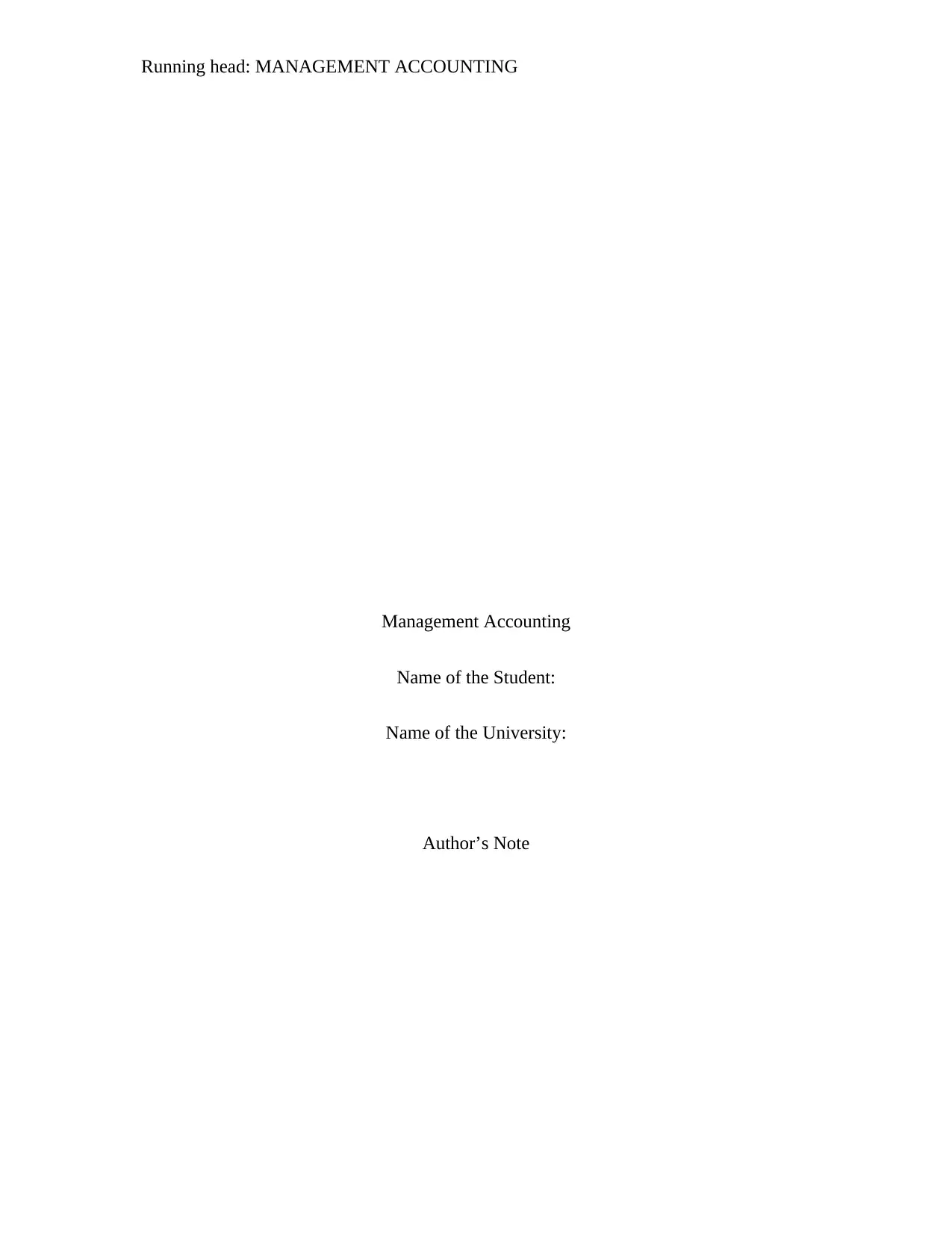
Running head: MANAGEMENT ACCOUNTING
Management Accounting
Name of the Student:
Name of the University:
Author’s Note
Management Accounting
Name of the Student:
Name of the University:
Author’s Note
Paraphrase This Document
Need a fresh take? Get an instant paraphrase of this document with our AI Paraphraser
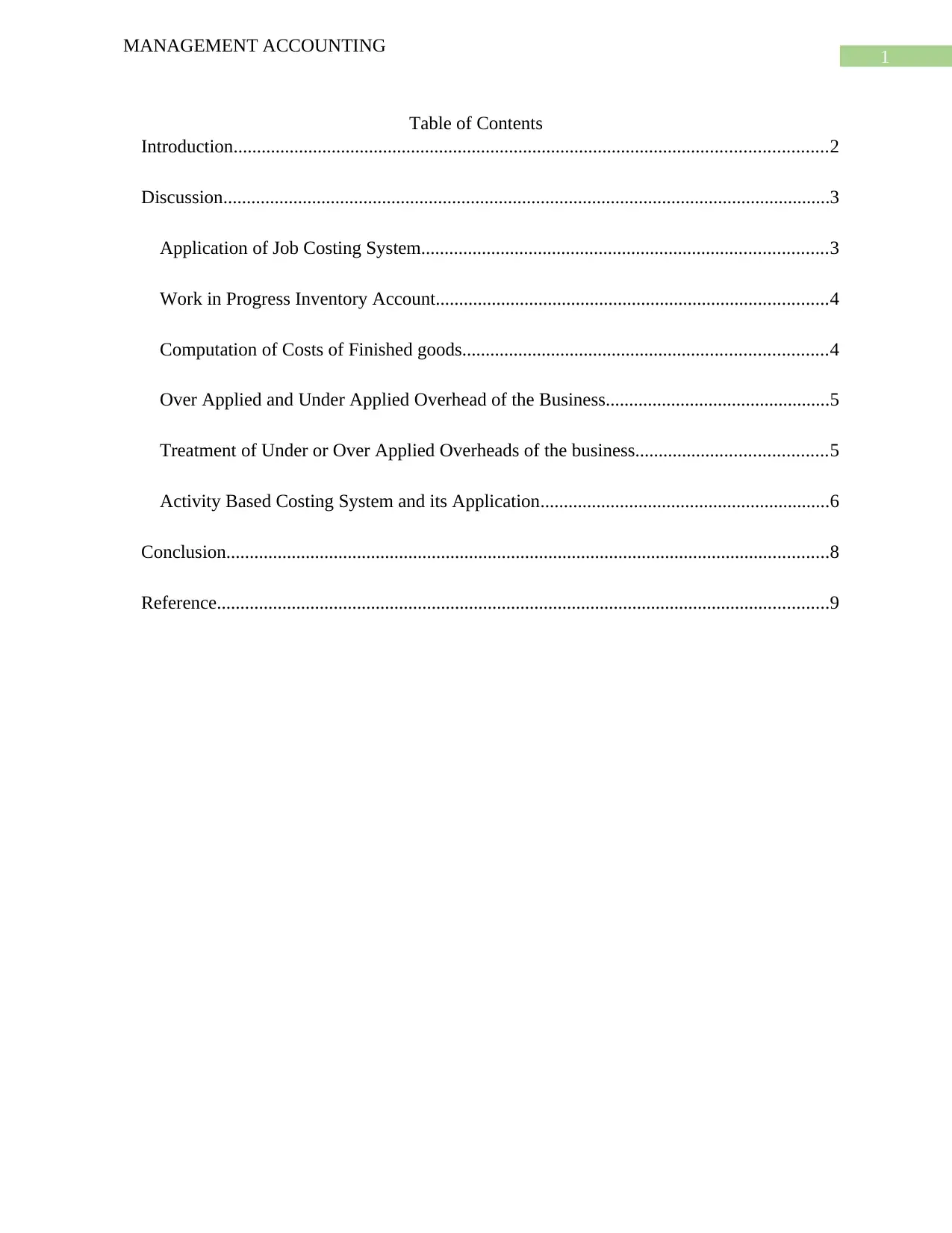
1
MANAGEMENT ACCOUNTING
Table of Contents
Introduction...............................................................................................................................2
Discussion..................................................................................................................................3
Application of Job Costing System.......................................................................................3
Work in Progress Inventory Account....................................................................................4
Computation of Costs of Finished goods..............................................................................4
Over Applied and Under Applied Overhead of the Business................................................5
Treatment of Under or Over Applied Overheads of the business.........................................5
Activity Based Costing System and its Application..............................................................6
Conclusion.................................................................................................................................8
Reference...................................................................................................................................9
MANAGEMENT ACCOUNTING
Table of Contents
Introduction...............................................................................................................................2
Discussion..................................................................................................................................3
Application of Job Costing System.......................................................................................3
Work in Progress Inventory Account....................................................................................4
Computation of Costs of Finished goods..............................................................................4
Over Applied and Under Applied Overhead of the Business................................................5
Treatment of Under or Over Applied Overheads of the business.........................................5
Activity Based Costing System and its Application..............................................................6
Conclusion.................................................................................................................................8
Reference...................................................................................................................................9
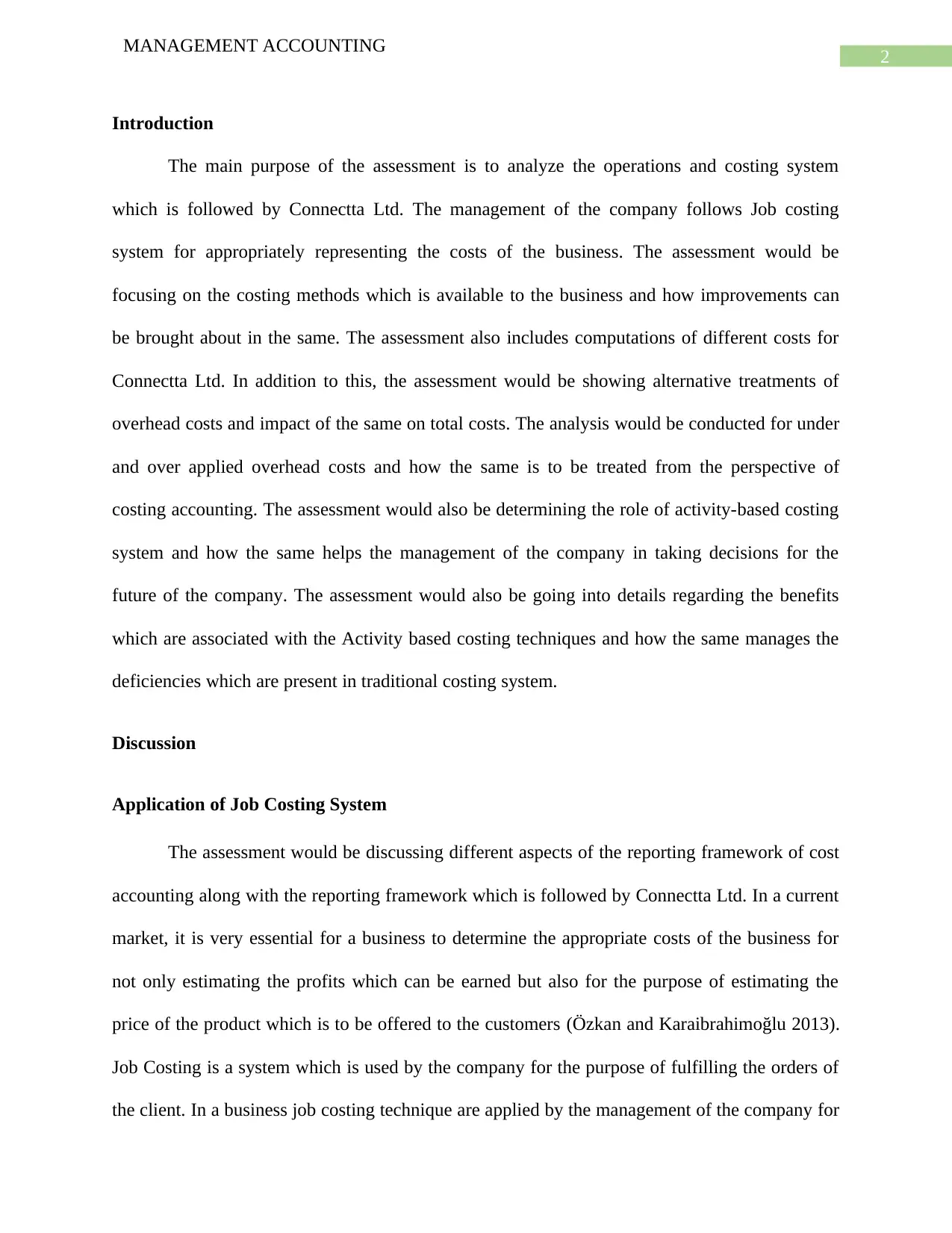
2
MANAGEMENT ACCOUNTING
Introduction
The main purpose of the assessment is to analyze the operations and costing system
which is followed by Connectta Ltd. The management of the company follows Job costing
system for appropriately representing the costs of the business. The assessment would be
focusing on the costing methods which is available to the business and how improvements can
be brought about in the same. The assessment also includes computations of different costs for
Connectta Ltd. In addition to this, the assessment would be showing alternative treatments of
overhead costs and impact of the same on total costs. The analysis would be conducted for under
and over applied overhead costs and how the same is to be treated from the perspective of
costing accounting. The assessment would also be determining the role of activity-based costing
system and how the same helps the management of the company in taking decisions for the
future of the company. The assessment would also be going into details regarding the benefits
which are associated with the Activity based costing techniques and how the same manages the
deficiencies which are present in traditional costing system.
Discussion
Application of Job Costing System
The assessment would be discussing different aspects of the reporting framework of cost
accounting along with the reporting framework which is followed by Connectta Ltd. In a current
market, it is very essential for a business to determine the appropriate costs of the business for
not only estimating the profits which can be earned but also for the purpose of estimating the
price of the product which is to be offered to the customers (Özkan and Karaibrahimoğlu 2013).
Job Costing is a system which is used by the company for the purpose of fulfilling the orders of
the client. In a business job costing technique are applied by the management of the company for
MANAGEMENT ACCOUNTING
Introduction
The main purpose of the assessment is to analyze the operations and costing system
which is followed by Connectta Ltd. The management of the company follows Job costing
system for appropriately representing the costs of the business. The assessment would be
focusing on the costing methods which is available to the business and how improvements can
be brought about in the same. The assessment also includes computations of different costs for
Connectta Ltd. In addition to this, the assessment would be showing alternative treatments of
overhead costs and impact of the same on total costs. The analysis would be conducted for under
and over applied overhead costs and how the same is to be treated from the perspective of
costing accounting. The assessment would also be determining the role of activity-based costing
system and how the same helps the management of the company in taking decisions for the
future of the company. The assessment would also be going into details regarding the benefits
which are associated with the Activity based costing techniques and how the same manages the
deficiencies which are present in traditional costing system.
Discussion
Application of Job Costing System
The assessment would be discussing different aspects of the reporting framework of cost
accounting along with the reporting framework which is followed by Connectta Ltd. In a current
market, it is very essential for a business to determine the appropriate costs of the business for
not only estimating the profits which can be earned but also for the purpose of estimating the
price of the product which is to be offered to the customers (Özkan and Karaibrahimoğlu 2013).
Job Costing is a system which is used by the company for the purpose of fulfilling the orders of
the client. In a business job costing technique are applied by the management of the company for
⊘ This is a preview!⊘
Do you want full access?
Subscribe today to unlock all pages.

Trusted by 1+ million students worldwide
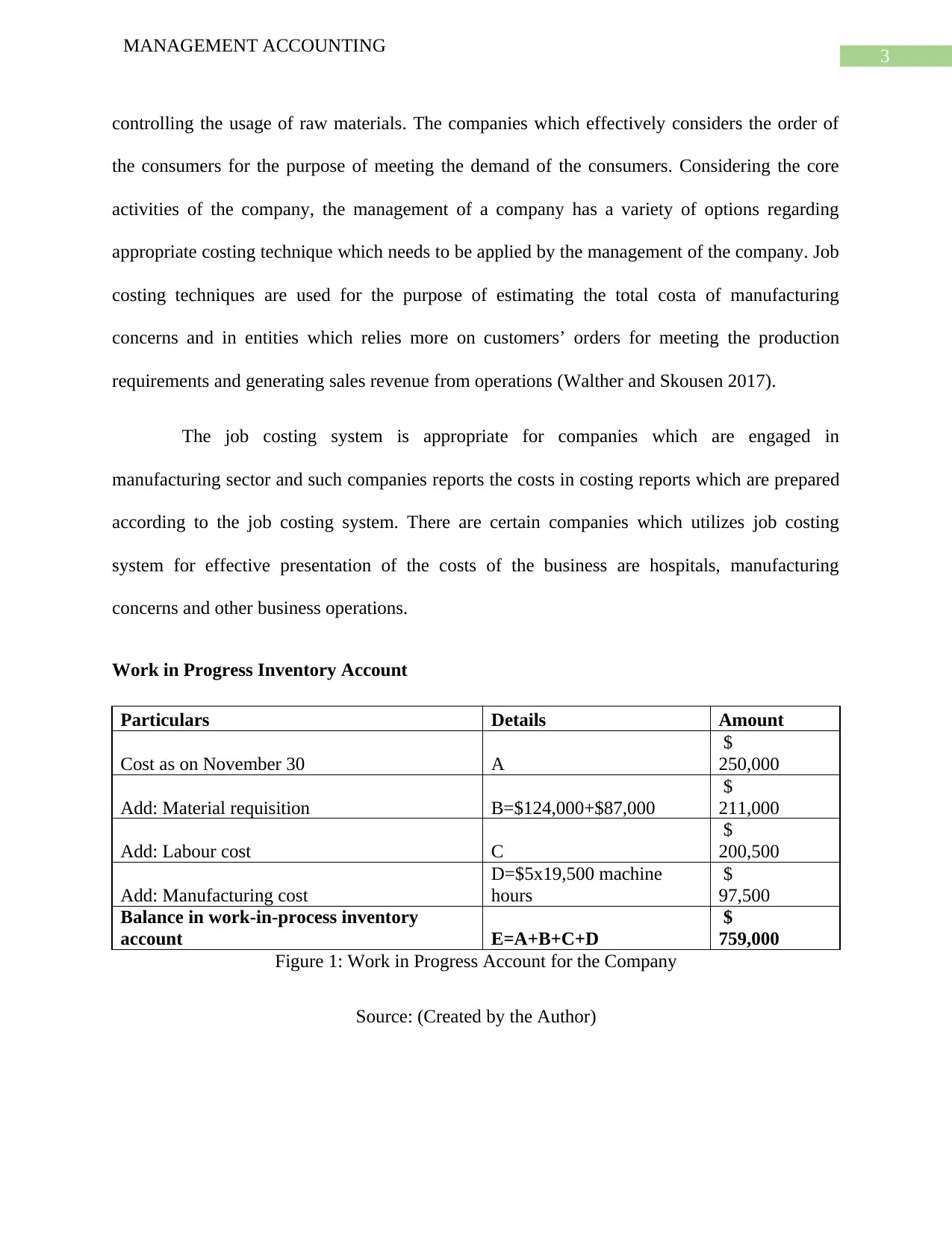
3
MANAGEMENT ACCOUNTING
controlling the usage of raw materials. The companies which effectively considers the order of
the consumers for the purpose of meeting the demand of the consumers. Considering the core
activities of the company, the management of a company has a variety of options regarding
appropriate costing technique which needs to be applied by the management of the company. Job
costing techniques are used for the purpose of estimating the total costa of manufacturing
concerns and in entities which relies more on customers’ orders for meeting the production
requirements and generating sales revenue from operations (Walther and Skousen 2017).
The job costing system is appropriate for companies which are engaged in
manufacturing sector and such companies reports the costs in costing reports which are prepared
according to the job costing system. There are certain companies which utilizes job costing
system for effective presentation of the costs of the business are hospitals, manufacturing
concerns and other business operations.
Work in Progress Inventory Account
Particulars Details Amount
Cost as on November 30 A
$
250,000
Add: Material requisition B=$124,000+$87,000
$
211,000
Add: Labour cost C
$
200,500
Add: Manufacturing cost
D=$5x19,500 machine
hours
$
97,500
Balance in work-in-process inventory
account E=A+B+C+D
$
759,000
Figure 1: Work in Progress Account for the Company
Source: (Created by the Author)
MANAGEMENT ACCOUNTING
controlling the usage of raw materials. The companies which effectively considers the order of
the consumers for the purpose of meeting the demand of the consumers. Considering the core
activities of the company, the management of a company has a variety of options regarding
appropriate costing technique which needs to be applied by the management of the company. Job
costing techniques are used for the purpose of estimating the total costa of manufacturing
concerns and in entities which relies more on customers’ orders for meeting the production
requirements and generating sales revenue from operations (Walther and Skousen 2017).
The job costing system is appropriate for companies which are engaged in
manufacturing sector and such companies reports the costs in costing reports which are prepared
according to the job costing system. There are certain companies which utilizes job costing
system for effective presentation of the costs of the business are hospitals, manufacturing
concerns and other business operations.
Work in Progress Inventory Account
Particulars Details Amount
Cost as on November 30 A
$
250,000
Add: Material requisition B=$124,000+$87,000
$
211,000
Add: Labour cost C
$
200,500
Add: Manufacturing cost
D=$5x19,500 machine
hours
$
97,500
Balance in work-in-process inventory
account E=A+B+C+D
$
759,000
Figure 1: Work in Progress Account for the Company
Source: (Created by the Author)
Paraphrase This Document
Need a fresh take? Get an instant paraphrase of this document with our AI Paraphraser
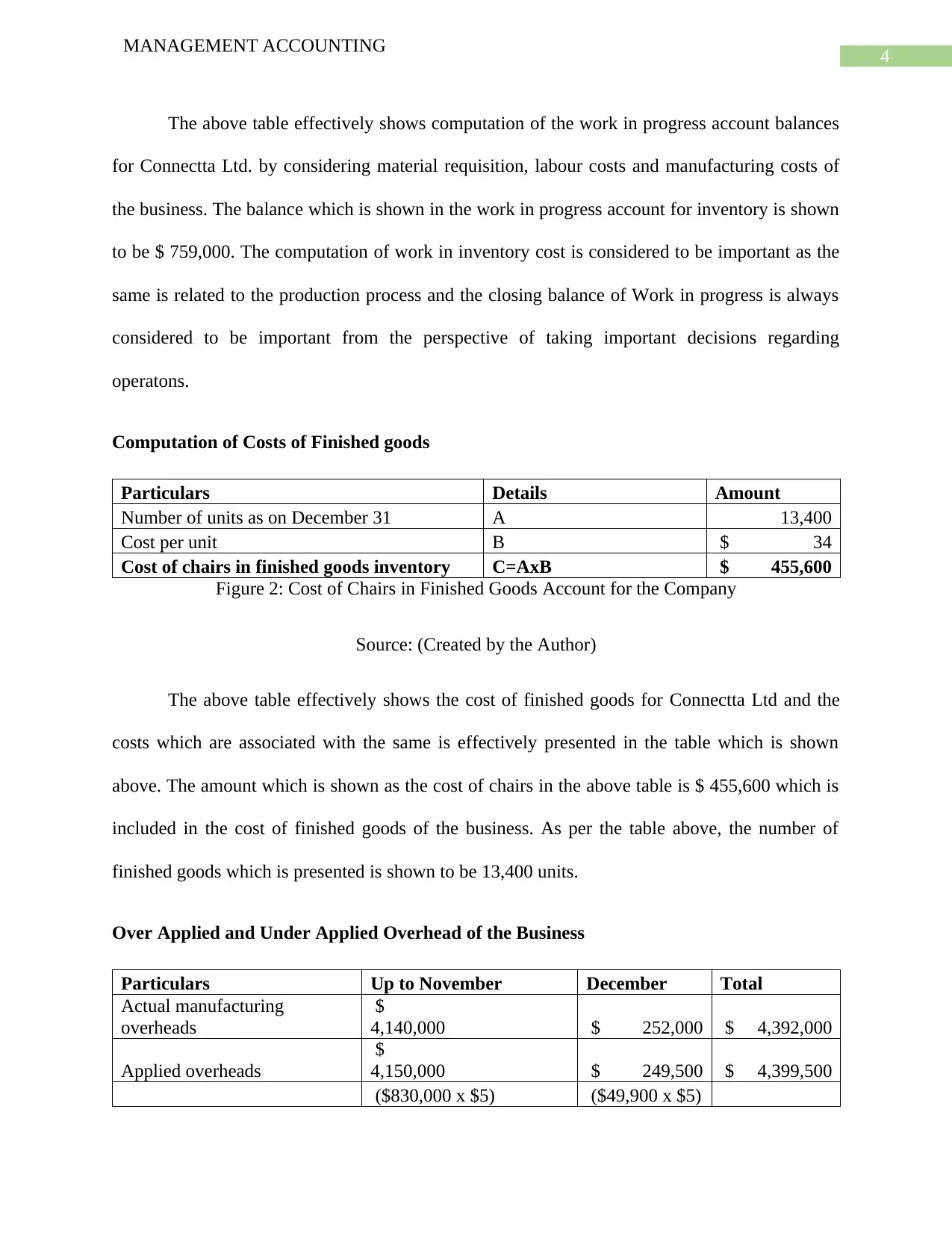
4
MANAGEMENT ACCOUNTING
The above table effectively shows computation of the work in progress account balances
for Connectta Ltd. by considering material requisition, labour costs and manufacturing costs of
the business. The balance which is shown in the work in progress account for inventory is shown
to be $ 759,000. The computation of work in inventory cost is considered to be important as the
same is related to the production process and the closing balance of Work in progress is always
considered to be important from the perspective of taking important decisions regarding
operatons.
Computation of Costs of Finished goods
Particulars Details Amount
Number of units as on December 31 A 13,400
Cost per unit B $ 34
Cost of chairs in finished goods inventory C=AxB $ 455,600
Figure 2: Cost of Chairs in Finished Goods Account for the Company
Source: (Created by the Author)
The above table effectively shows the cost of finished goods for Connectta Ltd and the
costs which are associated with the same is effectively presented in the table which is shown
above. The amount which is shown as the cost of chairs in the above table is $ 455,600 which is
included in the cost of finished goods of the business. As per the table above, the number of
finished goods which is presented is shown to be 13,400 units.
Over Applied and Under Applied Overhead of the Business
Particulars Up to November December Total
Actual manufacturing
overheads
$
4,140,000 $ 252,000 $ 4,392,000
Applied overheads
$
4,150,000 $ 249,500 $ 4,399,500
($830,000 x $5) ($49,900 x $5)
MANAGEMENT ACCOUNTING
The above table effectively shows computation of the work in progress account balances
for Connectta Ltd. by considering material requisition, labour costs and manufacturing costs of
the business. The balance which is shown in the work in progress account for inventory is shown
to be $ 759,000. The computation of work in inventory cost is considered to be important as the
same is related to the production process and the closing balance of Work in progress is always
considered to be important from the perspective of taking important decisions regarding
operatons.
Computation of Costs of Finished goods
Particulars Details Amount
Number of units as on December 31 A 13,400
Cost per unit B $ 34
Cost of chairs in finished goods inventory C=AxB $ 455,600
Figure 2: Cost of Chairs in Finished Goods Account for the Company
Source: (Created by the Author)
The above table effectively shows the cost of finished goods for Connectta Ltd and the
costs which are associated with the same is effectively presented in the table which is shown
above. The amount which is shown as the cost of chairs in the above table is $ 455,600 which is
included in the cost of finished goods of the business. As per the table above, the number of
finished goods which is presented is shown to be 13,400 units.
Over Applied and Under Applied Overhead of the Business
Particulars Up to November December Total
Actual manufacturing
overheads
$
4,140,000 $ 252,000 $ 4,392,000
Applied overheads
$
4,150,000 $ 249,500 $ 4,399,500
($830,000 x $5) ($49,900 x $5)
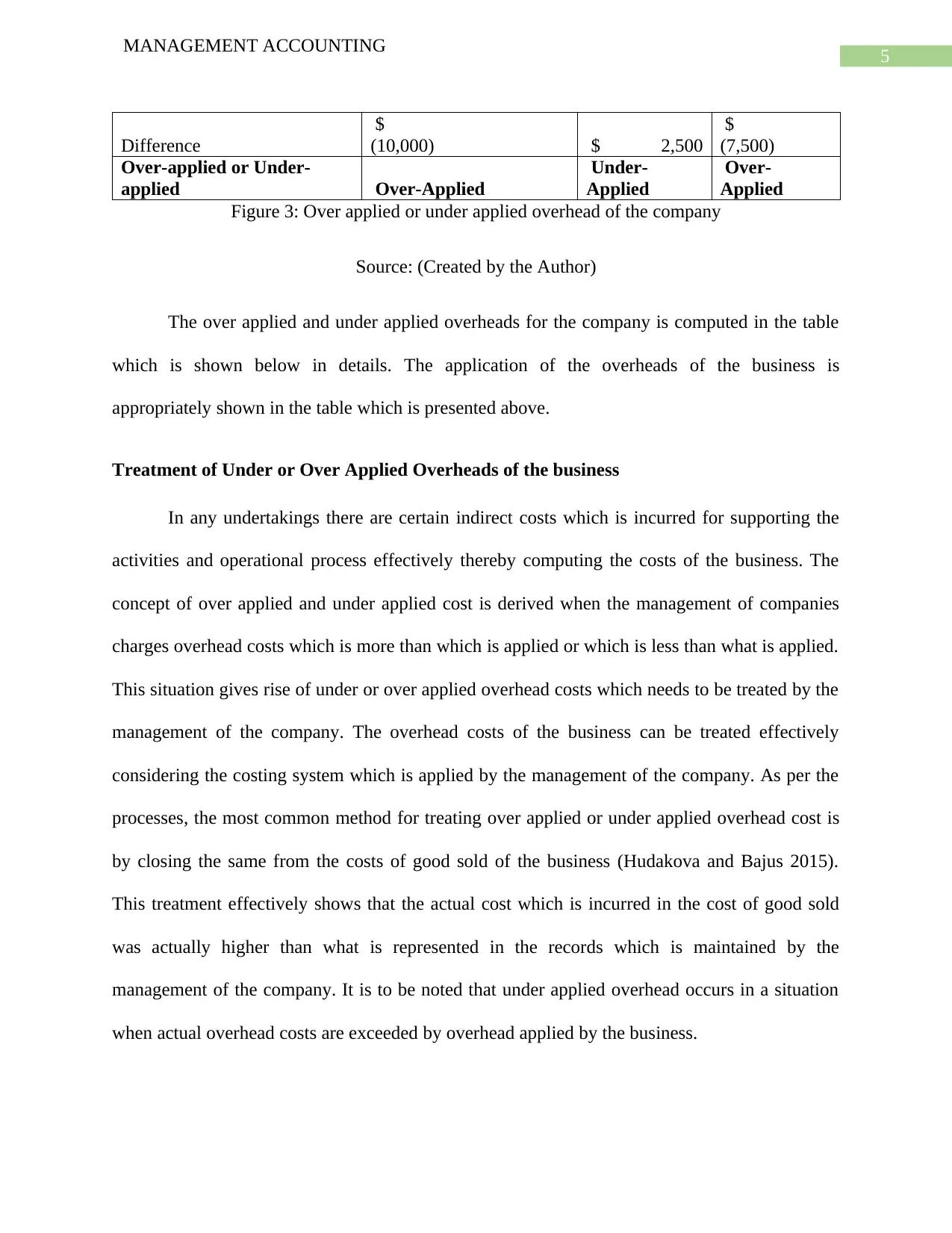
5
MANAGEMENT ACCOUNTING
Difference
$
(10,000) $ 2,500
$
(7,500)
Over-applied or Under-
applied Over-Applied
Under-
Applied
Over-
Applied
Figure 3: Over applied or under applied overhead of the company
Source: (Created by the Author)
The over applied and under applied overheads for the company is computed in the table
which is shown below in details. The application of the overheads of the business is
appropriately shown in the table which is presented above.
Treatment of Under or Over Applied Overheads of the business
In any undertakings there are certain indirect costs which is incurred for supporting the
activities and operational process effectively thereby computing the costs of the business. The
concept of over applied and under applied cost is derived when the management of companies
charges overhead costs which is more than which is applied or which is less than what is applied.
This situation gives rise of under or over applied overhead costs which needs to be treated by the
management of the company. The overhead costs of the business can be treated effectively
considering the costing system which is applied by the management of the company. As per the
processes, the most common method for treating over applied or under applied overhead cost is
by closing the same from the costs of good sold of the business (Hudakova and Bajus 2015).
This treatment effectively shows that the actual cost which is incurred in the cost of good sold
was actually higher than what is represented in the records which is maintained by the
management of the company. It is to be noted that under applied overhead occurs in a situation
when actual overhead costs are exceeded by overhead applied by the business.
MANAGEMENT ACCOUNTING
Difference
$
(10,000) $ 2,500
$
(7,500)
Over-applied or Under-
applied Over-Applied
Under-
Applied
Over-
Applied
Figure 3: Over applied or under applied overhead of the company
Source: (Created by the Author)
The over applied and under applied overheads for the company is computed in the table
which is shown below in details. The application of the overheads of the business is
appropriately shown in the table which is presented above.
Treatment of Under or Over Applied Overheads of the business
In any undertakings there are certain indirect costs which is incurred for supporting the
activities and operational process effectively thereby computing the costs of the business. The
concept of over applied and under applied cost is derived when the management of companies
charges overhead costs which is more than which is applied or which is less than what is applied.
This situation gives rise of under or over applied overhead costs which needs to be treated by the
management of the company. The overhead costs of the business can be treated effectively
considering the costing system which is applied by the management of the company. As per the
processes, the most common method for treating over applied or under applied overhead cost is
by closing the same from the costs of good sold of the business (Hudakova and Bajus 2015).
This treatment effectively shows that the actual cost which is incurred in the cost of good sold
was actually higher than what is represented in the records which is maintained by the
management of the company. It is to be noted that under applied overhead occurs in a situation
when actual overhead costs are exceeded by overhead applied by the business.
⊘ This is a preview!⊘
Do you want full access?
Subscribe today to unlock all pages.

Trusted by 1+ million students worldwide
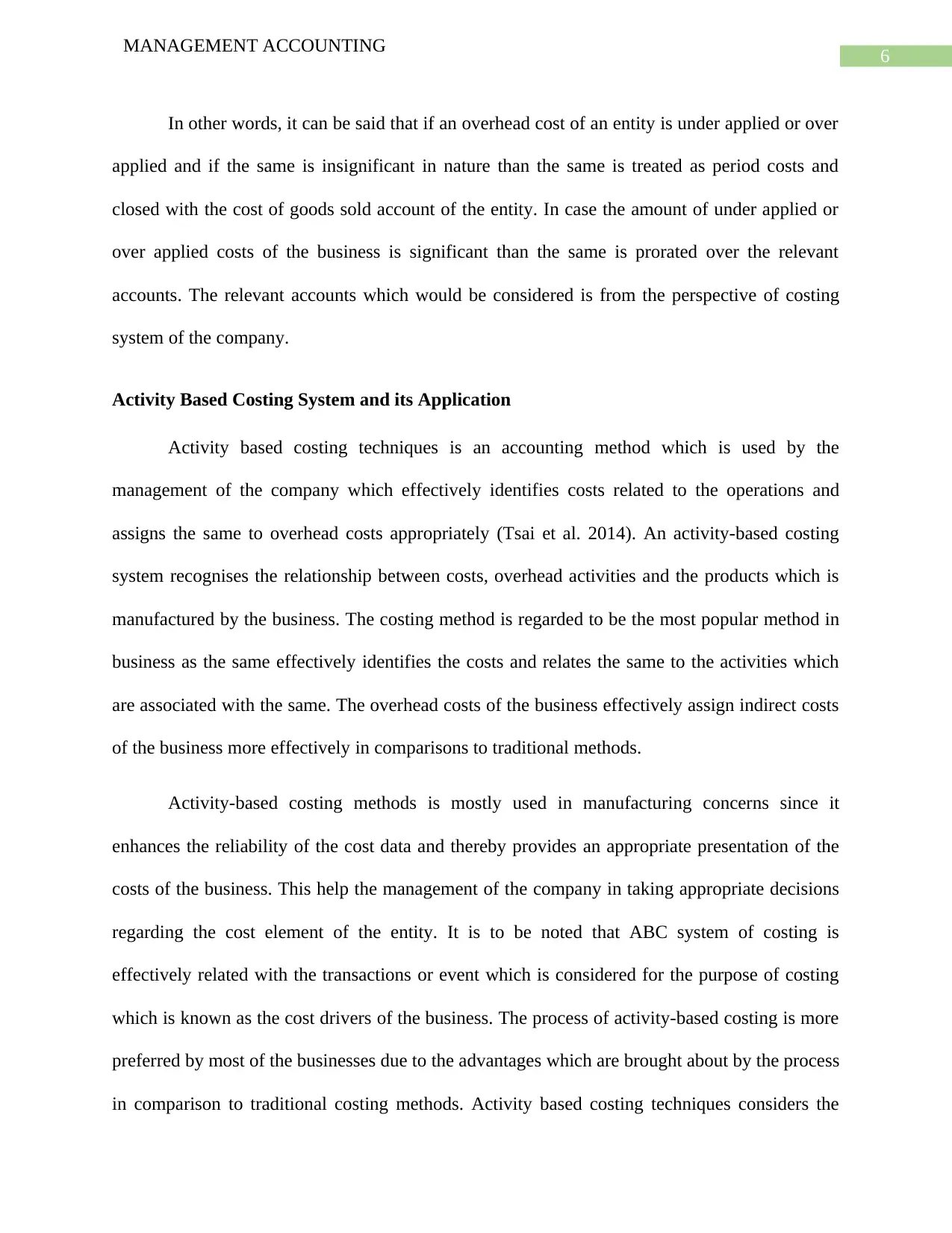
6
MANAGEMENT ACCOUNTING
In other words, it can be said that if an overhead cost of an entity is under applied or over
applied and if the same is insignificant in nature than the same is treated as period costs and
closed with the cost of goods sold account of the entity. In case the amount of under applied or
over applied costs of the business is significant than the same is prorated over the relevant
accounts. The relevant accounts which would be considered is from the perspective of costing
system of the company.
Activity Based Costing System and its Application
Activity based costing techniques is an accounting method which is used by the
management of the company which effectively identifies costs related to the operations and
assigns the same to overhead costs appropriately (Tsai et al. 2014). An activity-based costing
system recognises the relationship between costs, overhead activities and the products which is
manufactured by the business. The costing method is regarded to be the most popular method in
business as the same effectively identifies the costs and relates the same to the activities which
are associated with the same. The overhead costs of the business effectively assign indirect costs
of the business more effectively in comparisons to traditional methods.
Activity-based costing methods is mostly used in manufacturing concerns since it
enhances the reliability of the cost data and thereby provides an appropriate presentation of the
costs of the business. This help the management of the company in taking appropriate decisions
regarding the cost element of the entity. It is to be noted that ABC system of costing is
effectively related with the transactions or event which is considered for the purpose of costing
which is known as the cost drivers of the business. The process of activity-based costing is more
preferred by most of the businesses due to the advantages which are brought about by the process
in comparison to traditional costing methods. Activity based costing techniques considers the
MANAGEMENT ACCOUNTING
In other words, it can be said that if an overhead cost of an entity is under applied or over
applied and if the same is insignificant in nature than the same is treated as period costs and
closed with the cost of goods sold account of the entity. In case the amount of under applied or
over applied costs of the business is significant than the same is prorated over the relevant
accounts. The relevant accounts which would be considered is from the perspective of costing
system of the company.
Activity Based Costing System and its Application
Activity based costing techniques is an accounting method which is used by the
management of the company which effectively identifies costs related to the operations and
assigns the same to overhead costs appropriately (Tsai et al. 2014). An activity-based costing
system recognises the relationship between costs, overhead activities and the products which is
manufactured by the business. The costing method is regarded to be the most popular method in
business as the same effectively identifies the costs and relates the same to the activities which
are associated with the same. The overhead costs of the business effectively assign indirect costs
of the business more effectively in comparisons to traditional methods.
Activity-based costing methods is mostly used in manufacturing concerns since it
enhances the reliability of the cost data and thereby provides an appropriate presentation of the
costs of the business. This help the management of the company in taking appropriate decisions
regarding the cost element of the entity. It is to be noted that ABC system of costing is
effectively related with the transactions or event which is considered for the purpose of costing
which is known as the cost drivers of the business. The process of activity-based costing is more
preferred by most of the businesses due to the advantages which are brought about by the process
in comparison to traditional costing methods. Activity based costing techniques considers the
Paraphrase This Document
Need a fresh take? Get an instant paraphrase of this document with our AI Paraphraser
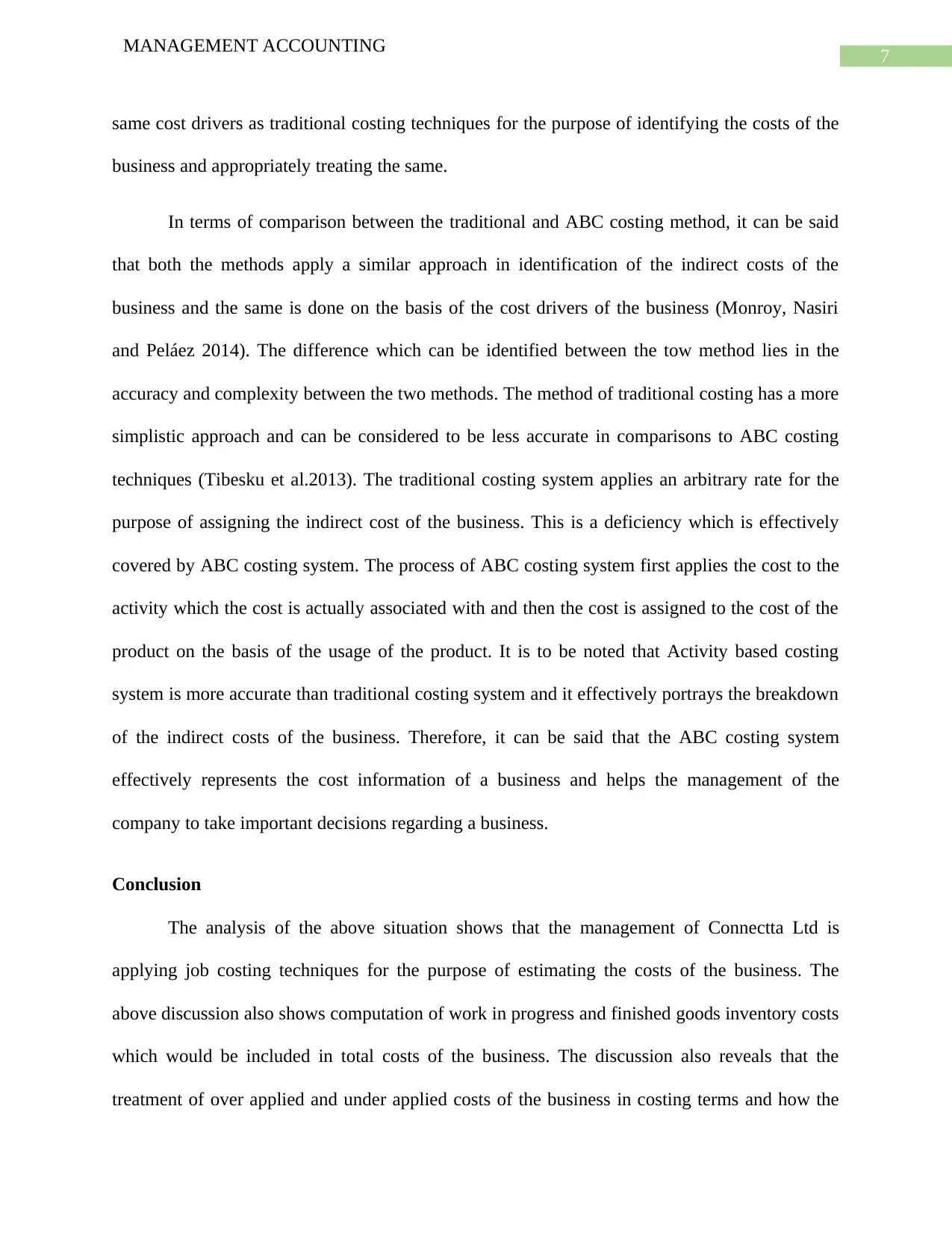
7
MANAGEMENT ACCOUNTING
same cost drivers as traditional costing techniques for the purpose of identifying the costs of the
business and appropriately treating the same.
In terms of comparison between the traditional and ABC costing method, it can be said
that both the methods apply a similar approach in identification of the indirect costs of the
business and the same is done on the basis of the cost drivers of the business (Monroy, Nasiri
and Peláez 2014). The difference which can be identified between the tow method lies in the
accuracy and complexity between the two methods. The method of traditional costing has a more
simplistic approach and can be considered to be less accurate in comparisons to ABC costing
techniques (Tibesku et al.2013). The traditional costing system applies an arbitrary rate for the
purpose of assigning the indirect cost of the business. This is a deficiency which is effectively
covered by ABC costing system. The process of ABC costing system first applies the cost to the
activity which the cost is actually associated with and then the cost is assigned to the cost of the
product on the basis of the usage of the product. It is to be noted that Activity based costing
system is more accurate than traditional costing system and it effectively portrays the breakdown
of the indirect costs of the business. Therefore, it can be said that the ABC costing system
effectively represents the cost information of a business and helps the management of the
company to take important decisions regarding a business.
Conclusion
The analysis of the above situation shows that the management of Connectta Ltd is
applying job costing techniques for the purpose of estimating the costs of the business. The
above discussion also shows computation of work in progress and finished goods inventory costs
which would be included in total costs of the business. The discussion also reveals that the
treatment of over applied and under applied costs of the business in costing terms and how the
MANAGEMENT ACCOUNTING
same cost drivers as traditional costing techniques for the purpose of identifying the costs of the
business and appropriately treating the same.
In terms of comparison between the traditional and ABC costing method, it can be said
that both the methods apply a similar approach in identification of the indirect costs of the
business and the same is done on the basis of the cost drivers of the business (Monroy, Nasiri
and Peláez 2014). The difference which can be identified between the tow method lies in the
accuracy and complexity between the two methods. The method of traditional costing has a more
simplistic approach and can be considered to be less accurate in comparisons to ABC costing
techniques (Tibesku et al.2013). The traditional costing system applies an arbitrary rate for the
purpose of assigning the indirect cost of the business. This is a deficiency which is effectively
covered by ABC costing system. The process of ABC costing system first applies the cost to the
activity which the cost is actually associated with and then the cost is assigned to the cost of the
product on the basis of the usage of the product. It is to be noted that Activity based costing
system is more accurate than traditional costing system and it effectively portrays the breakdown
of the indirect costs of the business. Therefore, it can be said that the ABC costing system
effectively represents the cost information of a business and helps the management of the
company to take important decisions regarding a business.
Conclusion
The analysis of the above situation shows that the management of Connectta Ltd is
applying job costing techniques for the purpose of estimating the costs of the business. The
above discussion also shows computation of work in progress and finished goods inventory costs
which would be included in total costs of the business. The discussion also reveals that the
treatment of over applied and under applied costs of the business in costing terms and how the
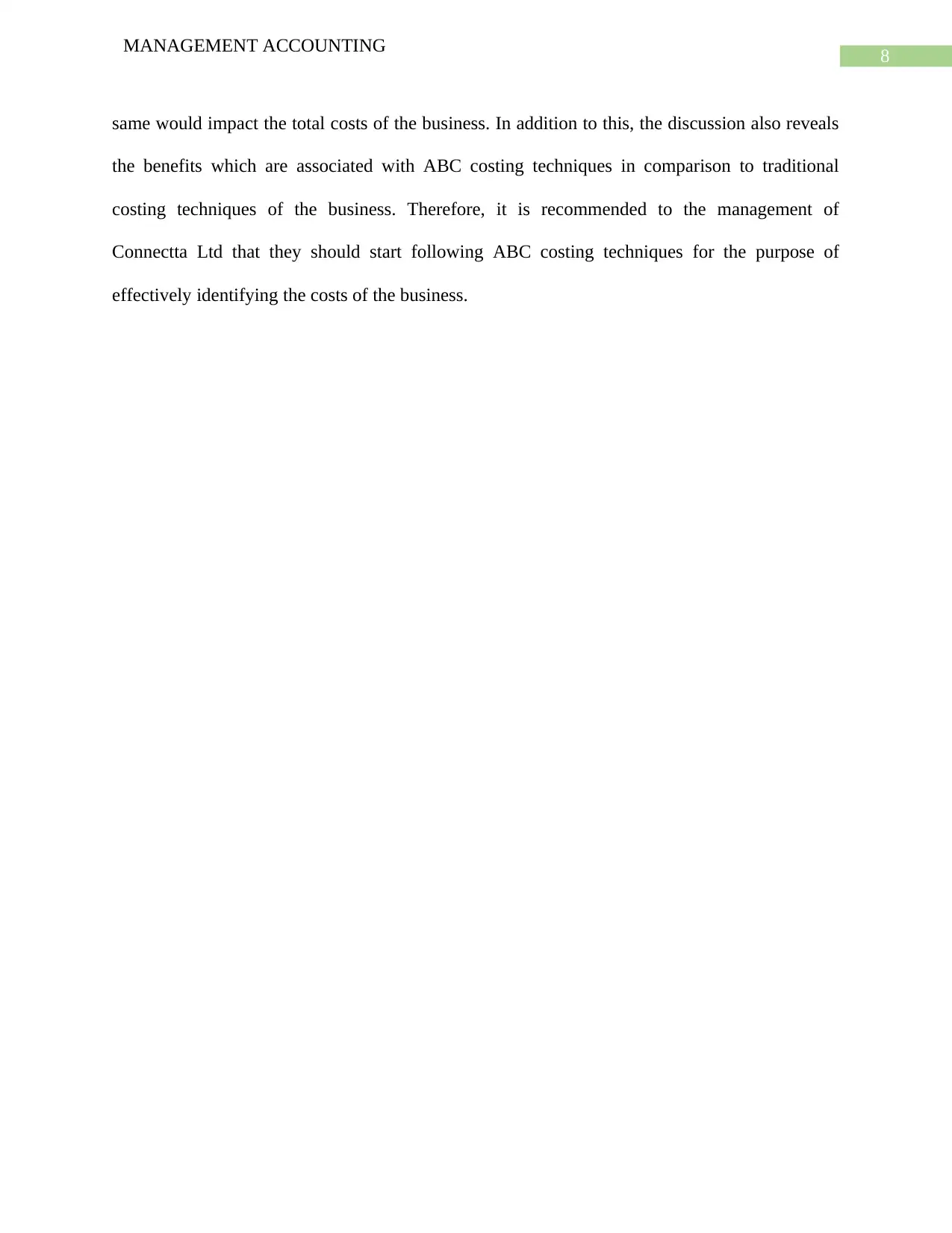
8
MANAGEMENT ACCOUNTING
same would impact the total costs of the business. In addition to this, the discussion also reveals
the benefits which are associated with ABC costing techniques in comparison to traditional
costing techniques of the business. Therefore, it is recommended to the management of
Connectta Ltd that they should start following ABC costing techniques for the purpose of
effectively identifying the costs of the business.
MANAGEMENT ACCOUNTING
same would impact the total costs of the business. In addition to this, the discussion also reveals
the benefits which are associated with ABC costing techniques in comparison to traditional
costing techniques of the business. Therefore, it is recommended to the management of
Connectta Ltd that they should start following ABC costing techniques for the purpose of
effectively identifying the costs of the business.
⊘ This is a preview!⊘
Do you want full access?
Subscribe today to unlock all pages.

Trusted by 1+ million students worldwide
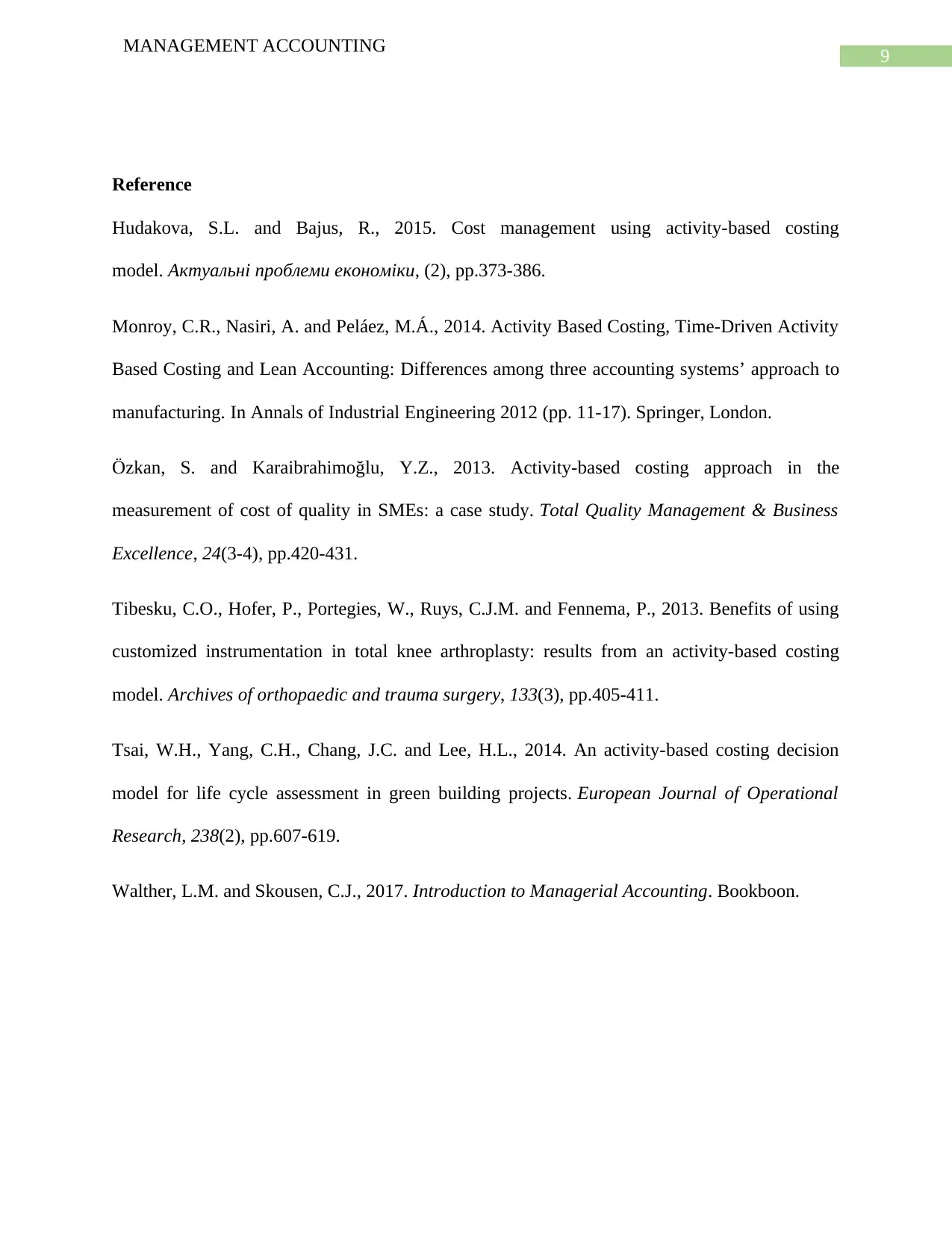
9
MANAGEMENT ACCOUNTING
Reference
Hudakova, S.L. and Bajus, R., 2015. Cost management using activity-based costing
model. Актуальні проблеми економіки, (2), pp.373-386.
Monroy, C.R., Nasiri, A. and Peláez, M.Á., 2014. Activity Based Costing, Time-Driven Activity
Based Costing and Lean Accounting: Differences among three accounting systems’ approach to
manufacturing. In Annals of Industrial Engineering 2012 (pp. 11-17). Springer, London.
Özkan, S. and Karaibrahimoğlu, Y.Z., 2013. Activity-based costing approach in the
measurement of cost of quality in SMEs: a case study. Total Quality Management & Business
Excellence, 24(3-4), pp.420-431.
Tibesku, C.O., Hofer, P., Portegies, W., Ruys, C.J.M. and Fennema, P., 2013. Benefits of using
customized instrumentation in total knee arthroplasty: results from an activity-based costing
model. Archives of orthopaedic and trauma surgery, 133(3), pp.405-411.
Tsai, W.H., Yang, C.H., Chang, J.C. and Lee, H.L., 2014. An activity-based costing decision
model for life cycle assessment in green building projects. European Journal of Operational
Research, 238(2), pp.607-619.
Walther, L.M. and Skousen, C.J., 2017. Introduction to Managerial Accounting. Bookboon.
MANAGEMENT ACCOUNTING
Reference
Hudakova, S.L. and Bajus, R., 2015. Cost management using activity-based costing
model. Актуальні проблеми економіки, (2), pp.373-386.
Monroy, C.R., Nasiri, A. and Peláez, M.Á., 2014. Activity Based Costing, Time-Driven Activity
Based Costing and Lean Accounting: Differences among three accounting systems’ approach to
manufacturing. In Annals of Industrial Engineering 2012 (pp. 11-17). Springer, London.
Özkan, S. and Karaibrahimoğlu, Y.Z., 2013. Activity-based costing approach in the
measurement of cost of quality in SMEs: a case study. Total Quality Management & Business
Excellence, 24(3-4), pp.420-431.
Tibesku, C.O., Hofer, P., Portegies, W., Ruys, C.J.M. and Fennema, P., 2013. Benefits of using
customized instrumentation in total knee arthroplasty: results from an activity-based costing
model. Archives of orthopaedic and trauma surgery, 133(3), pp.405-411.
Tsai, W.H., Yang, C.H., Chang, J.C. and Lee, H.L., 2014. An activity-based costing decision
model for life cycle assessment in green building projects. European Journal of Operational
Research, 238(2), pp.607-619.
Walther, L.M. and Skousen, C.J., 2017. Introduction to Managerial Accounting. Bookboon.
1 out of 10
Related Documents
Your All-in-One AI-Powered Toolkit for Academic Success.
+13062052269
info@desklib.com
Available 24*7 on WhatsApp / Email
![[object Object]](/_next/static/media/star-bottom.7253800d.svg)
Unlock your academic potential
Copyright © 2020–2025 A2Z Services. All Rights Reserved. Developed and managed by ZUCOL.





